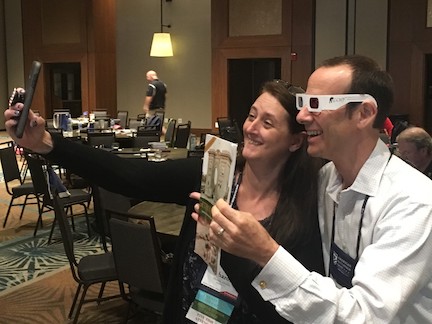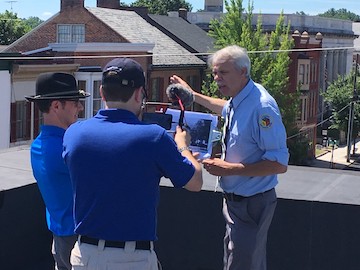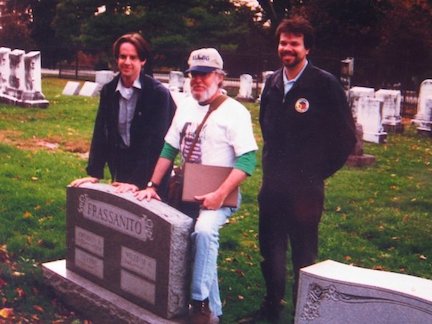A Conversation with Garry Adelman (part one)

part one of a six-part series
If anyone in the Civil War community sets the bar for excitement and enthusiasm, it’s Garry Adelman. Garry is the chief historian for the American Battlefield Trust, and during his time with ABT, he has made himself into a household name through his embrace of social media and his explosive energy. As Garry often says, he’s excited about sharing Civil War history, and he wants to do everything he can to help his audiences be excited about it, too.
I had the chance to sit down with Garry for an extended conversation about how he got into Civil War history, how his career evolved, and the impact social media has had on the field. During the course of our conversation, we also got to talk about his passion for battlefield preservation, his fascination with Civil War photography, and his work as a historian.
Our conversation has been lightly edited for length and clarity.

Chris Mackowski: I think the place I’d like to start is last summer, when we were on the roof of the Fahnestock Building in Gettysburg doing a Facebook LIVE for the American Battlefield Trust, and from where we were standing, we could look down onto Baltimore Street and see the former restaurant you used to own.
Garry Adelman: Yes.
Chris: And, to me, that’s a fascinating journey of you going from street level to roof level.
Garry: Ooh, interesting metaphor.
Chris: Can you trace that journey a little bit for me?
Garry: I became obsessed with the Civil War in high school by picking up William Frassanito’s books.
Chris: That’s a two-for-one, because it’s Civil War and it’s photography—your two big things. How did that steer you?
Garry: I was always that kid—I don’t know why—but when I was seven, I’d see a picture from when I was three and wonder where it was taken, and I’d want to go back and take another picture of it. For whatever reason, this was burned into me. And in high school, my freshman year, I would take pictures of buildings before they were demolished with the intent of going back and taking a picture of it later after it was demolished. So, I don’t know why, but this idea of time passing over a certain place has been of interest to me since I was a little boy.
Chris: That’s fascinating.
Garry: I have no idea why. So, in my last day of sophomore year of high school, when I was not a good history student at all because I didn’t read for pleasure, and didn’t read most of what was assigned me, I finished my exam early and went to the Evanston Township High School Library—massive library—and I have no idea why, but I walked over to the 973’s and pulled this book with bright red letters saying “Antietam” on the side. I didn’t know what Antietam was. I guess I knew the north fought the south, but not much more about that. When I stress that I was 16 years old and didn’t know what the Civil War was, I mean it. And I pulled that book off the shelf and opened to a page that showed dead bodies lying in front of the Dunker Church with a pair of shoes lying there, and then a picture of the same place today, it immediately hit me. I couldn’t wait to get back in the Fall and check that book out. (chuckles) I didn’t think to go to another library and get it, I guess.
But, that was it. I became obsessed with it. I got The American Heritage book after that. And then suddenly for birthdays and Hanukkah, people were giving me Civil War books, and I was suddenly reading for pleasure. That’s what changed. That changed everything that very moment.
So, suddenly, there was an author who was doing what I’m now naturally born to do, study time and place together, and here it was in a book. He was the first one I’d ever seen do it, and he really pioneered this. And my kids know this: they would not exist were it not for William A. Frassanito. There is no doubt about it. I’d have never moved to Gettysburg or met my wife were it not for getting obsessed with his books.
That book hit what was already naturally in me. And I suspect it’s done that for thousands of other, ‘cause when you talk to Frassanito people—he prefers “Frassa-maniacs,” I prefer “Frassa-idiots,” and I mean that in a good way, just like I call myself a Civil War loser, and that’s a compliment. That’s when “buff” and “nerd” ain’t enough. You go to “loser.” People don’t always take that the right way, but that’s part of me being a little mean—for whatever reason, his approach, this “then and now” thing, has really hit a nerve with a lot of people.

Tim Smith and I, we are officially his students and he is our mentor, and he sends us out to do his work to some extent, and I’m really proud to be in that position. If I see somebody on the field with a Frassanito book struggling to find a modern location—because his moderns were taken in the ’70s and ’80s—I always help them because, on my first trip to Gettysburg, a man did that for me. He saw me with my Fraz book—F-R-A-Z—and he helped me and I’ll never forget it.
So, literally because of Frassanito’s Antietam book, I was instantly obsessed. I started reading really for pleasure for the first time in my life and obsessed about it for the coming years really. I still went to school to get a business degree in hotel and restaurant management, but I was more obsessed with history at the time—I just didn’t think I could make money at it.
Chris: Yeah.
Garry: During college a couple of times I visited Gettysburg and Antietam and Fredericksburg. Then I was really hooked. I didn’t know what “obsessed” was until those first few trips.
Chris: What was you first experience on a battlefield like?
Garry: Yeah, so though the Antietam book was my real entry, when I read the Gettysburg book, I was really obsessed. Then I got his Grant and Lee book, and I just knew I had to visit a battlefield. I couldn’t make that happen until July of 1988, the 125th anniversary of Gettysburg. That’s not why I went, but that’s when I was able to work it out.
I was in college at the time, and during the summer I was doing restaurant stuff, running a busy booth at the Taste of Chicago. After that experience, after working ten straight twelve-, thirteen-hour days, I flew out to Gettysburg and visited a girlfriend of mine who was living in Baltimore at the time. And all I wanted to do was drive out to Gettysburg and Antietam, which I did—twice I drove out to Gettysburg during that trip—and because I was so obsessed I thought something almost supernatural would happen. You know, I would touch the rocks and I’d close my eyes….
It ended up being a little anti-climactic—with a distinct exception of walking around the woods at Devil’s Den on the road, and I kind of had a feel, spacially, for where I was because of the then-and-now photos. I knew what was where, but I didn’t exactly know with any detail. Things never quite sit the way you think they are until you go.
But I turned the corner on Sickles Avenue, and I was writing “somewhere in Devil’s Den,” and then I looked up and saw the dead sharpshooter’s position, with which I was particularly obsessed, and I stopped right there and stopped walking and wrote:
“WOH, I just saw the dead sharpshooter’s position; I’m trembling + I can’t breath (sic.) right – my heart is pounding quickly + my mouth is dry; this is Amazing.”

I wrote that in my journal upon glimpsing the site, before I even walked up to it.
Within two minutes, I’d set up my camera on a tripod and laid down in the same spot, because to me I was getting closer with my subject. And that’s not for everyone. You know, people interact with battlefields in different ways. A lot of people wonder what the code of conduct is on a battlefield. What are you supposed to do at this place? Can you have fun? Does it have to be all heavy reverence? Can there be some irreverence? I’ve seen people be happy, I’ve seen them be sad, I’ve seen them be confused, I’ve seen them be angry, I’ve seen them lash out at the tour guide, I’ve seen them pass out, I’ve seen them cry, and whatnot.
I look to the veterans: they had fun. They used a battlefield for various things while they also paid honor to the sacrifices their comrades and their own deeds. So, I think there’s a pretty wide boundary of what’s okay on a battlefield. You don’t have to lay down in the spot of the dead—that’s a little bit morbid to many. To me, it brings me closer to the subject.
Chris: While you’re discovering this connection to the battlefield, though, you’re still carrying on life as usual, too, right?
Garry: Yeah, I’d been working for a really prominent restaurant corporation in Chicago. I had a great job. So, when I got out of college, I started managing a restaurant and did that for about two and a half years. Restaurant people work a lot, and you don’t get a lot of vacation, especially when you’re first starting out, so I would close up the restaurant on Saturday night, once in a while at 2:00 a.m., start driving, and get there—it’s about a 12-hour drive from Chicago, and with the time change, I’d get there at about, you know, 3:00 p.m. the next day—and I’d spend a couple of hours ’til it got dark, then I’d spend the whole next day, then I’d drive back. It was just nuts. And I did this 11 times.
One day my car broke down on the side of the road, and it was in rural Michigan—and everybody was so nice, they helped me out—and right then and there I decided, “I have to get out of the city.” I was 25; I had gray hair—some gray hair—I had more hair than I do now but some of it was already gray at the time. I was stressed out, and I just then and there pretty much decided “I’m going to move to Gettysburg” without a job. Which is what I did!
I tried to find work as a restaurant manager because everybody needs that, right, except bad idea to move to a tourist town in September where they’re not hiring. So, unable to find a job, my then-girlfriend and I opened a restaurant there on the corner of Baltimore and Middle Street. It was called The Food for Thought Café and Coffee House, and it was a little ahead of its time because it was a health food restaurant and coffee house. This was 1992/93. We were the only espresso machine within 30 miles.
————
So, that gets young Garry Adelman to Gettysburg. What gets him into the Civil War? He’ll answer that question in our next installment.
I was lucky enough to attend the January 2014 Antietam Teacher Institute with Garry leading the tour as I researched the Antietam chapter of my regimental history of the 65th NY Volunteers, “No Flinching From Fire.” And it was 60 degrees and sunny! For that matter, I was lucky enough to bump into Dr, Mackowski manning a visitor’s kiosk at Spotsylvania as I searched in the summer of 2016 for Upton’s farm road using Dr. Mackowski’s book as my guide! He signed his book, then he showed me how to find the old roadbed. Two of the warmest, friendliest Civil War experts you will ever meet! I am looking forward to the rest of this interview.
I appreciate the kind words. I’m glad I was able to help you find the roadbed, too–it’s a “hidden gem” on the battlefield.
Maybe when I retire I can join you on one of your annual May 10th walks along the road. ?
Garry is such a pleasure to know. This is a fascinating interview.
He was fun to interview. And I agree, he’s a pleasure to know. Good guy.
He gives a shout-out to your roundtable later in the series. 😉
Your quite a guide yourself Chris
Thanks, Mike. I appreciate it!
Pleasing to read of such enthusiasm.
Garry has it in spades–and he’s really like that in real life. It’s not an act for the camera.
A Civil War goofball. Can’t believe this is only 7 posts long. Dude is a motormouth.
I actually reorganized it into six parts. Same amount of words; posts will just each be a little longer.